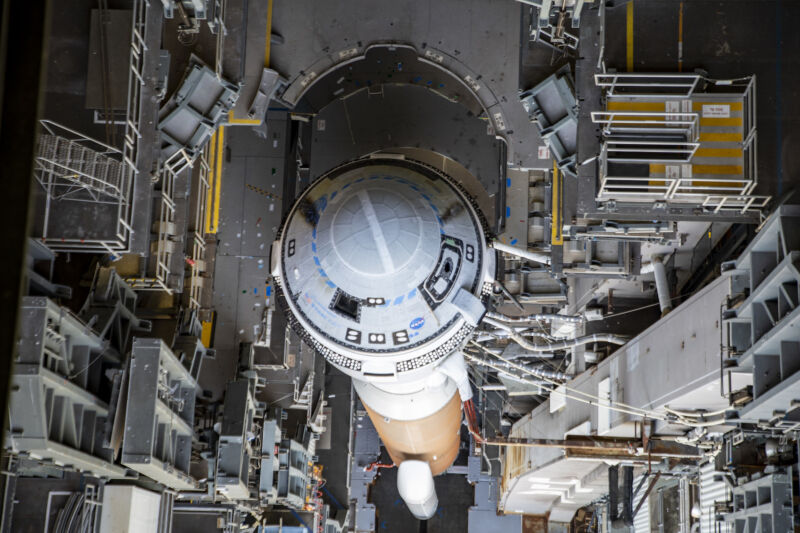
Boeing is taking a few extra days to resolve a small helium leak on the Starliner spacecraft slated to ferry two NASA astronauts on a test flight to the International Space Station, officials said Tuesday.
This means the first crew launch of Boeing's Starliner spacecraft, running years behind schedule and more than $1.4 billion over budget, won't happen before next Tuesday, May 21, at 4:43 pm EDT (20:43 UTC). Meeting this schedule assumes engineers can get comfortable with the helium leak. Officials from Boeing and NASA, which manages Boeing's multibillion-dollar Starliner commercial crew contract, previously targeted Friday, May 17, for the spacecraft's first launch with astronauts onboard.
Boeing's ground team traced the leak to a flange on a single reaction control system thruster on the spacecraft's service module.
There are 28 reaction control system thrusters—essentially small rocket engines—on the Starliner service module. In orbit, these thrusters are used for minor course corrections and pointing the spacecraft in the proper direction. The service module has two sets of more powerful engines for larger orbital adjustments and launch-abort maneuvers.
The spacecraft's propulsion system is pressurized using helium, an inert gas. The thrusters burn a mixture of toxic hydrazine and nitrogen tetroxide propellants. Helium is not combustible or toxic, so a small leak is not likely to be a major safety issue on the ground, but the propulsion system must hold pressure for the thrusters to work in space.
Multiple technical setbacks have kept Boeing's Starliner program from reaching this point until now. These setbacks included a fuel leak on a test stand, software problems on Starliner's first unpiloted test flight, and corroded valves in the spacecraft's propulsion system. In the run-up to a launch attempt last summer, Boeing and NASA discovered two more problems—flammable material inside the capsule and a weak link on Starliner's parachute system—that pushed back the crew test flight nearly a year.
According to NASA, engineers plan to address the helium leak using "spacecraft testing and operational solutions." In other words, managers don't anticipate any need to physically repair the leak.
"As a part of the testing, Boeing will bring the propulsion system up to flight pressurization just as it does prior to launch, and then allow the helium system to vent naturally to validate existing data and strengthen flight rationale," NASA officials wrote in a blog post Tuesday. Flight rationale is NASA-speak for gaining confidence in understanding a problem and getting comfortable it would not pose an added risk during the flight.
Rocket is good to go
A valve failure on the Atlas V rocket set to launch Boeing's Starliner crew capsule cut short the first launch attempt for the crew test flight May 6 at Cape Canaveral Space Force Station, Florida. United Launch Alliance, the company that builds and operates the Atlas V, rolled the rocket and Starliner off the launch pad and back to a hangar last week to swap out the faulty pressure regulation valve on the Atlas V's Centaur upper stage.
Once installed on the rocket, the new valve performed normally in tests inside ULA's hangar. ULA will roll the rocket back to the launch pad a couple of days before the next launch attempt.
"Mission teams also completed a thorough review of the data from the May 6 launch attempt and are not tracking any other issues," NASA said.
NASA astronauts Butch Wilmore and Suni Williams, commander and pilot for the Starliner test flight, returned to their home base in Houston to spend more time with their families and wait for the mission's next launch date. They will return to the Kennedy Space Center in Florida in the coming days for final launch preps, NASA said.
Wilmore and Williams, both US Navy test pilots, will oversee Starliner's systems from launch through docking at the International Space Station. Their tasks include taking over manual control of the Boeing crew capsule for a series of piloting demonstrations. If all goes according to plan, they will spend at least eight days at the space station before returning to Earth inside the Starliner spacecraft for a parachute-assisted, airbag-cushioned landing in the southwestern United States, likely at White Sands, New Mexico.
Their stay at the space station could be extended to wait for good weather at one of Starliner's landing sites. With the upcoming flight of Starliner, the United States will, for the first time since the dawn of the Space Age, have two independent human-rated spaceships capable of flying people into low-Earth orbit. SpaceX's Crew Dragon, which won a NASA commercial crew contract at the same time as Boeing in 2014, started flying astronauts in 2020.
NASA's commercial crew contract with Boeing covers six operational crew rotation flights to and from the space station. A successful test flight with Wilmore and Williams would pave the way for Starliner to fly the first of these six-month crew missions early next year.
Article From & Read More ( Boeing is troubleshooting a small helium leak on the Starliner spacecraft - Ars Technica )https://ift.tt/CwWL5Zs
Science
No comments:
Post a Comment